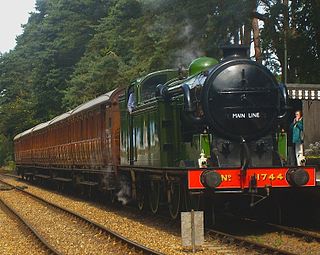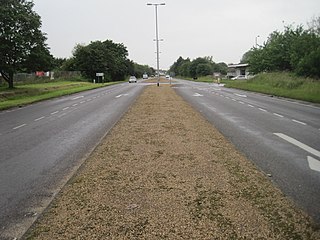
The North Norfolk Railway (NNR) – also known as the "Poppy Line" – is a 5+1⁄4-mile (8.4 km) heritage steam railway in Norfolk, England, running between the towns of Sheringham and Holt. The North Norfolk Railway is owned and operated as a public limited company, originally called Central Norfolk Enterprises Limited. The railway is listed as exempt from the UK Railways (Interoperability) Regulations 2000.

The Midland and Great Northern Joint Railway (M&GNJR) was a railway network in England, in the area connecting southern Lincolnshire, the Isle of Ely and north Norfolk. It developed from several local independent concerns and was incorporated in 1893. It was jointly owned by the Midland Railway and the Great Northern Railway, and those companies had long sponsored and operated the predecessor companies.

The Bittern Line is a railway branch line in Norfolk, England, that links Norwich to Sheringham. It passes through the Broads on its route to an Area of Outstanding Natural Beauty on the north Norfolk coast. It is named after the bittern, a rare bird found in the reedy wetlands of Norfolk.

Norwich railway station is the northern terminus of the Great Eastern Main Line in the East of England, serving the cathedral city of Norwich, Norfolk. It is 114 miles 77 chains (185.0 km) down the main line from London Liverpool Street, the western terminus.

Salhouse railway station is on the Bittern Line in Norfolk, England, serving the village of Salhouse. It is the next station along the line from Norwich, 5 miles 74 chains (9.5 km) from that terminus; the following station is Hoveton & Wroxham. Train services are operated by Greater Anglia.

North Walsham railway station is on the Bittern Line in Norfolk, England, serving the town of North Walsham. It is 16 miles (26 km) down the line from Norwich, between Worstead to the south and Gunton to the north. Train services are operated by Greater Anglia.
The Norfolk and Suffolk Joint Railway (NSJR) was a British joint railway company.

Roughton Road railway station is on the Bittern Line in Norfolk, England, on the outskirts of the town of Cromer. It takes its name from the street on which it is located, and is several miles north of the village of Roughton. It is 24 miles 1 chain (38.6 km) down the line from Norwich and is situated between Gunton and Cromer stations.

The fishing port and holiday resort of Cromer in the English county of Norfolk has had a rail service since 1877. It was served by three railway stations for many years, and is now served by two. Cromer Beach station, which opened in 1887, was renamed Cromer following the closure of the other early stations.

West Runton railway station is on the Bittern Line in Norfolk, England, serving the village of West Runton. It is 28 miles 55 chains (46.2 km) down the line from Norwich and is situated between Cromer and Sheringham, the northern terminus. Train services are operated by Greater Anglia.

Sheringham railway station is the northern terminus of the Bittern Line in Norfolk, England, serving the town of Sheringham. It is 30 miles 22 chains down the line from Norwich. Its three-letter station code is SHM.

Cromer High railway station was the first station opened in Cromer, Norfolk, in England. It is situated to the south on the outskirts of the town on a steep escarpment. Built initially by the short-lived East Norfolk Railway, the station was incorporated into the Great Eastern Railway, who had operated the services from the beginning. It served as the terminus of Great Eastern Railway services from London and Norwich. Initially named Cromer on opening, it was renamed Cromer High on 27 September 1948.

The Norfolk Orbital Railway – as the Holt, Melton Constable and Fakenham Railway Company – is a proposed rail project in Norfolk, England, which is proposed to look at bringing a new rail connection to North and Mid Norfolk.

Melton Constable was a railway station on the Midland and Great Northern Railway which served the North Norfolk village of Melton Constable from 1882 to 1964. Notwithstanding its rural location, the station became an important railway centre with lines converging from all directions providing connections to key East Anglian towns such as King's Lynn, Norwich, Cromer, Fakenham, Yarmouth and Lowestoft. Although long since demolished, there is a possibility that the station may yet be resurrected as part of the proposed Norfolk Orbital Railway.

Holt railway station was a railway station that served the town of Holt in Norfolk, England. It was part of the Midland and Great Northern Joint Railway network, which spread over much of East Anglia, providing connections to Cromer, Norwich and Yarmouth. Closed in 1964. It has since been closed and occupied by a main road. There are proposals to rebuild the line through the town as part of an orbital railway scheme and possibly a new station to serve the town.

Sheringham is the name of a preserved railway station in Sheringham, Norfolk. It was once part of the Midland and Great Northern Joint Railway network and closed in 1967 when a new station was opened by British Rail approx. 200m eastwards. Since 1975 it has served as the eastern terminus of the North Norfolk Railway. In March 2010, the link to Network Rail was reinstated.

Railways have played an important part in the history and development of the English county of Norfolk. It currently has thirty open National Rail stations, though there were once well over a hundred.
The Cromer line was a railway branch in Norfolk, England that connected the railway junction of Melton Constable with Cromer on the sea.

The East Norfolk Railway was a pre-grouping railway company operating a standard gauge 25 mile, mostly single track, railway running between Norwich Thorpe railway station and Cromer in the English county of Norfolk. It opened in 1874, reaching Cromer three years later, and remains mostly operational. The company also operated a branch between Wroxham and County School, which closed to passengers in 1952, and had proposed a branch to Blakeney in 1878, which was never constructed.

Melton Constable railway works was a railway maintenance and production facility on the Midland and Great Northern Railway. The buildings and operations in the village of Melton Constable from 1883 to 1964 were vital to the village economy and indeed it is known that the village itself was created to house the employees who worked there. The works are known by many as the 'Crewe of North Norfolk' as Crewe was similar to Melton Constable, although on a much larger scale. Since the loss of the works and rail links the village has never recovered to pre World War I levels.



















